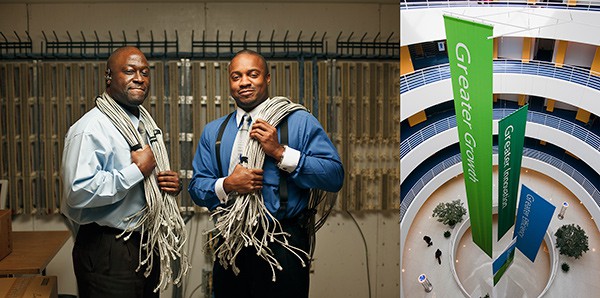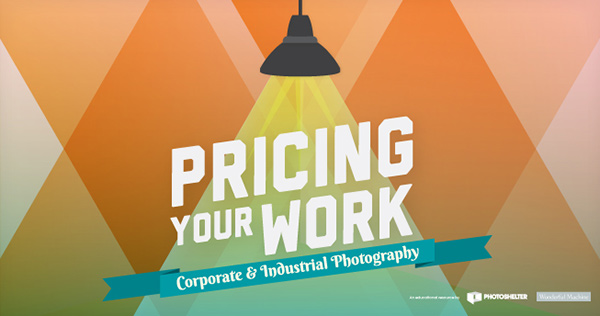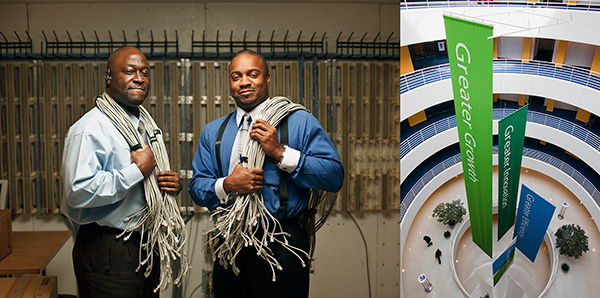Share
Pricing Your Work, Tip #5: How Much Can You Charge for Different Corporate Assignments?
This is the last in a series of blog posts exploring pricing your work from our 3 free guides written with Bill Cramer, CEO of Wonderful Machine. W...

This is the last in a series of blog posts exploring pricing your work from our 3 free guides written with Bill Cramer, CEO of Wonderful Machine. We’ve been sharing tips via the blog all this week on how to price your magazine photography, corporate & industrial photography, and photojournalism. Get the guide Pricing Your Work: Corporate & Industrial Photography here.
 Here, Bill Cramer, founder and CEO of Wonderful Machine breaks down the major types of corporate assignments, what they entail, and why each are important to clients. This is an excerpt from the free guide Pricing Your Work: Corporate & Industrial Photography.
Here, Bill Cramer, founder and CEO of Wonderful Machine breaks down the major types of corporate assignments, what they entail, and why each are important to clients. This is an excerpt from the free guide Pricing Your Work: Corporate & Industrial Photography.
Event Photography:
Event photography usually entails simply documenting meetings, speakers, ground-breaking ceremonies and other photo opportunities. This probably occupies the lowest rung on the pricing food chain because not only does it require the least amount of skill, but it requires very little equipment and the pictures tend to be used only for internal (or other modest) purposes. These events usually do not to lend themselves to making interesting or important pictures that might otherwise be more valuable to the client. A typical fee can land around $100 – $200/hour (for shoot time and post-processing time) plus incidental expenses like mileage, parking, tolls and meals. Some photographers charge half their shooting rate for travel time to and from the shoot. From a licensing standpoint, most companies will want publicity and internal collateral use (plus social media) forever. It’s not unusual to exclude print collateral and advertising use and negotiate an additional fee when the need arises.
Headshots:
Corporate headshots are typically lit head-and-shoulders pictures on a seamless paper background or against a simple out-of-focus background. Mostly, these come with a low to moderate budget when the pictures are for press kits, websites and other general use, since these shoots are not very demanding and there are many photographers who can handle them. However, if they’re specifically being shot for an annual report or some other high-profile publication, a higher level of quality will be expected and bigger budget will normally be available. A photographer can typically charge $150 – $300/hour for shoot time and $100 – $150/hour for post-processing time plus assistant, seamless paper, mileage, parking, tolls, and meals. Again, some photographers charge half their shooting rate for travel time. Charging separately for photographic equipment is not uncommon for many assignments, but somewhat unusual for headshots. If you have established a regular rate for a particular client, it may make sense to stick to that for headshots too. But if it’s a first time client, charging by the head shot will probably make more sense for both the photographer and the client. (A typical rate might be around $500 for the first headshot and $100 – $200 for each additional including post processing.) That way, the photographer is getting paid in proportion to their productivity and the client is being charged in proportion to the value they’re getting. Charging for headshots by the hour or by the day can set up a situation where the more productive the photographer is, the less they’re getting paid per picture. At the lower end of the pricing spectrum, we would normally include publicity and collateral use forever, excluding annual report use, which along with advertising use will be negotiated separately. Some clients will want to include annual report use, but be sure to factor that into the fee if that’s the case. It’s almost un- heard of to include advertising use unless you’re shooting the pictures for that purpose in the first place (and for much higher fees).
Corporate Reportage:
These images normally depict people in real working situations, but with more sophistication than event photography. The pictures usually do not require much in the way of equipment or crew, but they demand a lot of finesse, awareness and a keen eye. These assignments come with at least moderate budgets as they require a decent level of expertise, and the pictures could have a wider variety of applications. Photographers can often charge around $1500 – $3000/day plus mileage, parking, tolls, meals and $100 – $150/hour for post processing time. Since the pictures tend to be shot in a photojournalistic style, assistants, strobe lighting and hair and make-up are rarely used. The licensing is typically publicity and collateral use forever, excluding annual report use, which along with advertising use will be negotiated separately. Photographers don’t normally charge separately for local travel.
Environmental Portraits:
Environmental portraits are often lit, always controlled, portraits of people full-body or cropped to the waist, sometimes multiple people, in a setting that helps tell their story. These shoots have moderate to high budgets due to the level of skill required, the moderate amount of equipment and crew necessary and the wide variety of uses that clients will find for them. Rates often fall between $2000 – $3000 a day plus $100 – $150/hour for post processing time, assistant ($250 – $350/day), mileage, parking, tolls, and meals. Some photographers charge separately for their photographic equipment. Depending on how important the picture is, it’s not unusual to bring along someone to handle hair/make-up, especially for female subjects. For male subjects, I’ll bring my own powder, sponges and an apron (to keep the powder off the subject’s cloth- ing). The licensing is typically publicity and collateral use forever, excluding annual report use, which along with advertising use will be negotiated separately. Photographers don’t normally charge separately for local travel.
Corporate Lifestyle:
These shoots can be executed with a reportage or portraiture approach (or fashion or landscape, for that matter), but always employ a photographer with a specific style and who brings a high degree of production value to the shoot. This will often include strobe lighting, hair & make-up, sometimes wardrobe, location scouting in advance of the shoot, as well as careful selection and directing of subjects. The production values of these pictures are such that fewer photographers can make them and they’re valuable to the client because they tend to be used to build a corporate brand. In addition to showing people at work, the pictures can sometimes strike a more symbolic or inspirational tone, like a hand-shake, someone looking out the window dreaming of the future. At its best, a good corporate lifestyle photographer can create pictures that can help define the image of the whole company. A typical fee can be $3000 – $6000/day plus $100 – $150/hour for post processing time, assistant, (sometimes digital tech, hair/makeup, wardrobe, casting, talent, location scouting), mileage, parking, tolls, and meals. The licensing is typically publicity and collateral use forever, excluding annual report use (at the lower end of the price range), which along with advertising use will be negotiated separately. Photographers don’t normally charge separately for local travel.
You can find examples of corporate lifestyle photos on the MetLife website. Click on the Insurance, Investments, Planning, Retirement, Employee Benefits and Life Advice tabs.
Library Shoots:
These shoots tend to sit at the top of the corporate photography food chain in terms of skill needed to pull them off properly and value to the client. The expectations production-wise are the same as corporate lifestyle, but instead of shooting a particular subject for a particular publication, library shoots are about creating a wide variety of images that could be used for all sorts of purposes across different divisions of a big company. As a result, photographers can charge $5000 – $7500/day plus expenses.
The licensing is typically publicity and collateral use forever, including annual report but excluding advertising use as that will be negotiated separately. It’s not uncommon to limit the number of images for a particular fee and offer an option to license additional images at a predetermined price per picture. As good as that might sound, we have also seen some highly sought-after photographers command as much as $15,000/day for corporate lifestyle and library shoots.
Get started with tips for pricing your corporate work, you can get the guide here:





